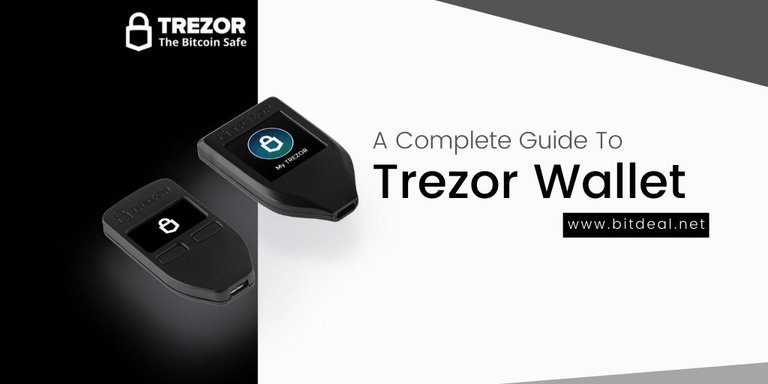
Cryptocurrency Hardware Wallet
We all may have experienced the usability of hot wallets that is online wallets, but the hardware wallets are opposite to the online wallets. This kind of hardware wallets will come as a security device which can hold the cryptocurrencies outside of an application connected to the internet or any other third party cloud storage, to avoid security theft, hackings or asset loss. Trezor is the first cryptocurrency hardware wallet, that made that ideology to work in real-life use cases for storing cryptocurrencies.
What Is Trezor Wallet?
Trezor Is the first introduced Cryptocurrency Hardware Wallet, that was introduced in 2014, by a cryptocurrency company, satoshilabs. Trezor can be called as the first cold wallet which has been invented to safely store bitcoins and other cryptocurrencies offline, that is outside of the internet connectivity. This wallet is like a USB device that can be connected with any kind of handheld and computer device like, mobile phone, tablet, desktop, wearables and more. The high-end security features of the trezor have attracted many cryptocurrency exchanges, traders, average bitcoiners towards it and have become the most trusted cryptocurrency hardware wallet. The arrival of Trezor has lifted the cryptocurrency protection to the next level.
So, I hope you now had a basic idea about trezor, before knowing about how to use trezor, let us unveil its security features, types, and how it works.
How Trezor Works?
Trezor is a single purpose cryptocurrency wallet, that is to store cryptocurrencies, approve transactions, and can help you to manage any kind of your digital identity. Trezor gives you a 100% guarantee for your assets and protects all the crypto entities from possible online and also offline security risks. Trezor never stores private keys to a system of devices connected to the internet and confirms the transactions away from the internet. Private data in trezor will not be leaked under any circumstances, rewritten, or erased even if you haven't used it for a long while. Trezor never requires a battery backup instead the power can be acquired via USB Connection.
Trezor Wallet Types
There are two models in trezor wallet, one is Trezor wallet one and Trezor wallet T. Each has some significant differences. Trezor wallet one was introduced on 29 January 2014 & Trezor T the premium model has been released on 26 February 2018. Let us have a short comparison between the two types of trezor wallets below.
Trezor One VS Trezor T : Full Features Comparison
Trezor One - it is a golden standard, and it is a first-generation wallet, raised with the single purpose that is to store cryptocurrency wallets, Whereas it resembles as a keychain and came with a minimalistic design. It weighs nearly 12 gms.
Trezor T - This is a premium standard of Trezor wallet, It has some special features better than trezor one has. Trezor T comes with a colorful LED touch screen, SD card Slot, Secure Device Input. Weighs 22 gms.
Trezor one
Made of ABS Impact Resistant ABS Plastic
Processor - ARM Cortex M3 running at 120MHz
Microcontroller - STM32 F2
Display - 128 x 64 OLED Display
Compatibility - Windows 7+, Linux, macOS 10.11+, Android.
Trezor One Technical Specifications
Source : Trezor One
**Trezor T **
Made of Reinforced ABS + PG Plastic, Ultrasonic Wedding
Processor - ARM Cortex M4 Processor Running on 168 MHz
Microcontroller - STM32F4
Display - 240 X 240 RGB LCD Display
Compatibility - Windows 7+, Linux, macOS 10.8+, Android.
Trezor T Technical Specifications
Source : Trezor Model T
Comparison Between Trezor One and Trezor T
Trezor One Vs Trezor T
Source : Trezor.io
Trezor Supported Coins
Trezor supports to store a variety of cryptocurrencies and tokens which includes Bitcoin, Ethereum, Litecoin, Monero, NEM, Dash coin and more. You can check out the entire list of coins that are supported by Trezor here.
Trezor Wallet Security Features
Trezor Wallet Security Features
Source : bitdegree.org
Firmware Verification - Trezor will warn you if the signature verification from bootloader not matched with SathoshiLabs.
Ultrasound Hardware Seal - The hardware is enriched with Ultrasonic welding.
Protected Key Operations - Private and Public Key operations are Authenticated with a PIN.
Secure Update Procedure - The bootloader will erase and update the memory only after successful firmware verification.
Additional Passphrase support - Supports BIP39 Phrases.
Write Protected Bootloader - The bootloader is fully write-protected as the JTAG is completely Disabled.
Reliable Backup & Recovery - With the use of recovery seed you can recover the lost data, and crypto assets.
Reference : trezor.io/security
Check out the other advanced features and Trezor Setup guide at originally published article : Trezor Wallet
Hi! I am a robot. I just upvoted you! I found similar content that readers might be interested in:
https://www.bitdeal.net/trezor-wallet